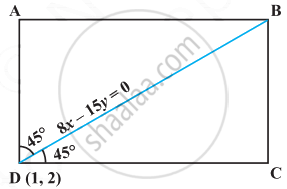Advertisements
Advertisements
प्रश्न
If one diagonal of a square is along the line 8x – 15y = 0 and one of its vertex is at (1, 2), then find the equation of sides of the square passing through this vertex.
उत्तर
Let ABCD be the given square and the coordinates of the vertex D be (1, 2).
We are required to find the equations of its sides DC and AD.
Given that BD is along the line 8x – 15y = 0, so its slope is `8/15` (Why?).
The angles made by BD with sides AD and DC is 45° (Why?).
Let the slope of DC be m.
Then tan 45° = `(m - 8/15)/(1 + (8m)/15)` (Why?)
or 15 + 8m = 15m – 8
or 7m = 23, which gives m = `23/7`
Therefore, the equation of the side DC is given by
y – 2 = `23/7 (x - 1)` or 23x – 7y – 9 = 0.
Similarly, the equation of another side AD is given by
y – 2 = `(-7)/23 (x - 1)` or 7x + 23y – 53 = 0.
APPEARS IN
संबंधित प्रश्न
Draw a quadrilateral in the Cartesian plane, whose vertices are (–4, 5), (0, 7), (5, –5) and (–4, –2). Also, find its area.
Find the distance between P (x1, y1) and Q (x2, y2) when :
- PQ is parallel to the y-axis,
- PQ is parallel to the x-axis
Find a point on the x-axis, which is equidistant from the points (7, 6) and (3, 4).
Consider the given population and year graph. Find the slope of the line AB and using it, find what will be the population in the year 2010?

Find the equation of the lines through the point (3, 2) which make an angle of 45° with the line x –2y = 3.
Find the slope of the lines which make the following angle with the positive direction of x-axis:
\[- \frac{\pi}{4}\]
Find the slope of a line passing through the following point:
(−3, 2) and (1, 4)
Find the slope of a line passing through the following point:
\[(a t_1^2 , 2 a t_1 ) \text { and } (a t_2^2 , 2 a t_2 )\]
State whether the two lines in each of the following are parallel, perpendicular or neither.
Through (5, 6) and (2, 3); through (9, −2) and (6, −5)
State whether the two lines in each of the following is parallel, perpendicular or neither.
Through (6, 3) and (1, 1); through (−2, 5) and (2, −5)
Find the slope of a line (i) which bisects the first quadrant angle (ii) which makes an angle of 30° with the positive direction of y-axis measured anticlockwise.
Without using Pythagoras theorem, show that the points A (0, 4), B (1, 2) and C (3, 3) are the vertices of a right angled triangle.
The slope of a line is double of the slope of another line. If tangents of the angle between them is \[\frac{1}{3}\],find the slopes of the other line.
Consider the following population and year graph:
Find the slope of the line AB and using it, find what will be the population in the year 2010.

Find the equation of a straight line with slope − 1/3 and y-intercept − 4.
Find the equation of the strainght line intersecting y-axis at a distance of 2 units above the origin and making an angle of 30° with the positive direction of the x-axis.
If the image of the point (2, 1) with respect to a line mirror is (5, 2), find the equation of the mirror.
Find the angles between the following pair of straight lines:
3x − y + 5 = 0 and x − 3y + 1 = 0
Prove that the points (2, −1), (0, 2), (2, 3) and (4, 0) are the coordinates of the vertices of a parallelogram and find the angle between its diagonals.
Show that the tangent of an angle between the lines \[\frac{x}{a} + \frac{y}{b} = 1 \text { and } \frac{x}{a} - \frac{y}{b} = 1\text { is } \frac{2ab}{a^2 - b^2}\].
The coordinates of the foot of the perpendicular from the point (2, 3) on the line x + y − 11 = 0 are
If the slope of a line passing through the point A(3, 2) is `3/4`, then find points on the line which are 5 units away from the point A.
A ray of light coming from the point (1, 2) is reflected at a point A on the x-axis and then passes through the point (5, 3). Find the coordinates of the point A.
Show that the tangent of an angle between the lines `x/a + y/b` = 1 and `x/a - y/b` = 1 is `(2ab)/(a^2 - b^2)`
Slope of a line which cuts off intercepts of equal lengths on the axes is ______.
The point (4, 1) undergoes the following two successive transformations:
(i) Reflection about the line y = x
(ii) Translation through a distance 2 units along the positive x-axis Then the final coordinates of the point are ______.
The points (3, 4) and (2, – 6) are situated on the ______ of the line 3x – 4y – 8 = 0.
The line `x/a + y/b` = 1 moves in such a way that `1/a^2 + 1/b^2 = 1/c^2`, where c is a constant. The locus of the foot of the perpendicular from the origin on the given line is x2 + y2 = c2.
